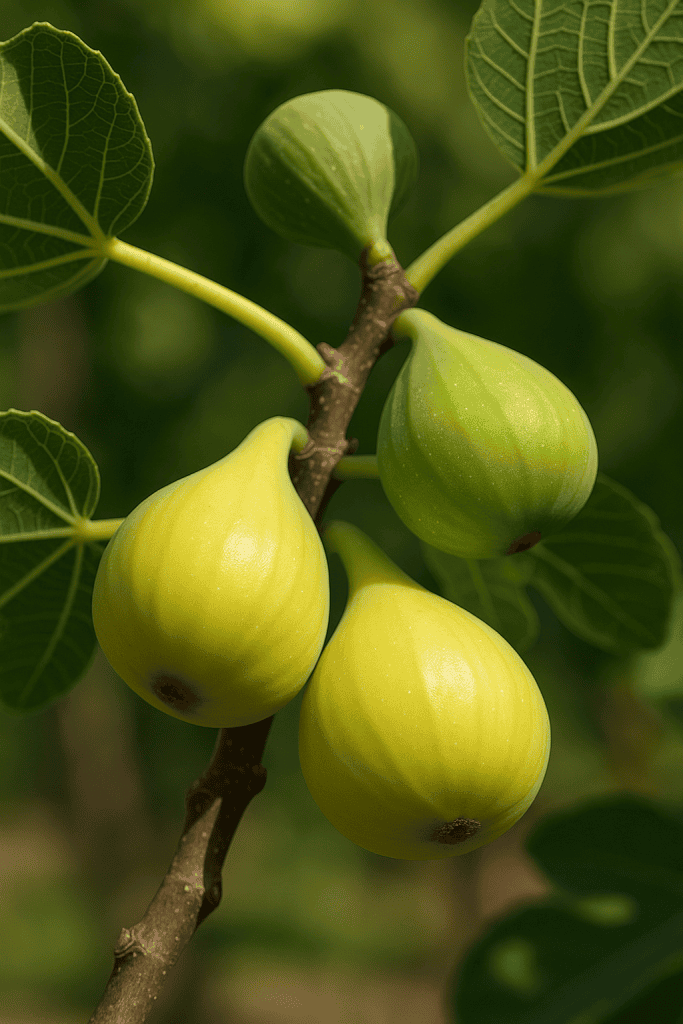Fig Varieties
The Kadota Fig – A Classic with a Twist
You ever meet someone who doesn’t say much at first—but then over time, you realize they’re kind of amazing? That’s the Kadota fig.
It’s not flashy. It doesn’t bleed jammy syrup like a Black Madeira or wear tiger stripes like a Panaché. But give it a moment. Give it some sun, a little patience, and the right soil—and you’ll find it’s one of the most rewarding figs to grow and eat. Understated, yes. Boring? Absolutely not.
Let me explain.
So… What Exactly Is a Kadota?
The Kadota fig is an old-school variety with deep roots (pun fully intended). It’s actually a variant of the ancient Dottato fig from Italy. Kadota is its Americanized cousin—adapted to California sunshine and a little more forgiving of backyard growers.
Technically, it’s a common fig, which means it doesn’t need a wasp or pollinator to produce fruit. That’s a major win for growers in non-tropical zones.
If you’ve ever had those greenish-yellow figs in a store, usually dried or sitting in a jar of syrup—that was probably Kadota. But don’t let the supermarket version fool you. Off the tree, sun-ripened and warm, they’re a whole different story.
Skin Like Sunshine, Flesh Like Honey
Kadota figs don’t play the color game. Their skin is soft yellow to light green, depending on how much direct sun they get. Sometimes there’s a blush on the shoulder—kind of like how some people tan unevenly. The inside is where things get interesting.
The flesh is a pale amber, almost translucent, with a silky, custard-like texture. The flavor? Subtle but sweet. Think fig newtons—but less cloying, more fresh. There’s a honeyed note, with soft vanilla undertones, and occasionally a mild nuttiness if the fig’s extra ripe.
Now, if you’re used to syrupy, in-your-face figs, Kadota might feel like a whisper. But sometimes whispers linger longer than shouts.
Growing Kadota: Chill, but Not Lazy
Let’s talk growth habit.
Kadota fig trees are vigorous but not unruly. They’ll grow into a medium-sized, well-shaped tree if left alone, or you can prune them low into a bushy form—whatever suits your space and picking style.
They’ve got thick, leathery leaves that handle heat like a champ. And when summer really cranks up, Kadota doesn’t flinch—it just keeps ripening. That’s one of the reasons commercial growers love it. But it also makes it great for home orchards, especially in areas with hot summers and erratic rain.
The fruit hangs tight and doesn’t split easily (looking at you, Panaché). You can wait until it’s perfectly ripe without worrying it’ll burst from one surprise shower.
Where It Thrives: Kadota’s Favorite Zones
Kadota grows best in USDA zones 8–10. If you’re in California, parts of Texas, Arizona, Florida, or the Southeast, it’ll feel right at home.
That said, I’ve seen growers push it into zone 7 with winter protection. Just know it’ll probably die back in frost, and you’ll have to treat it more like a perennial bush than a tree.
It also does surprisingly well in large containers. So if you’re up north but love the idea of fresh figs, Kadota might be your intro plant. Just wheel it inside when winter shows up.

My Personal Take: A Fig That Grew on Me
Okay, full honesty—Kadota wasn’t love at first bite for me.
I was knee-deep in dark jammy figs and had a serious crush on Black Madeira. Kadota seemed… tame. Too clean. Like fig-lite.
But then I got a tree from a local nursery (mainly for the grow zone compatibility), and the first summer it set fruit, I gave it a real shot. Ripe off the tree, still warm, that flavor hit different. No syrup bomb. Just honey, melon, and a little floral note that felt like something between white tea and garden herbs.
Over time, it became the fig I reached for when I didn’t want sticky fingers and a sugar rush. It’s also the one my neighbors always compliment—“That green fig? Way better than I expected.”
A Little Tangent: When “Mild” Is a Compliment
We get so obsessed with big flavors—salt bombs, chili oil, triple espresso—that sometimes we forget how good subtle can be. Kadota’s not going to compete with a Mission fig for drama, but it has this calm sweetness that pairs beautifully with cheese boards, light desserts, and even grilled meats.
I’ve used them with goat cheese and basil in summer salads. I’ve roasted them with rosemary and honey. And they hold their shape, which makes them fantastic for baking.
They’re kind of the fig version of a neutral wine—you can pair them with anything, and they’ll make everything else shine a little more.
Is Kadota for You?
Alright, let’s cut to it.
You’ll love Kadota if:
-
You live in a warm zone and want a low-maintenance fig.
-
You like subtle sweetness and firm fruit.
-
You enjoy preserving, baking, or drying figs.
You might not love it if:
-
You’re all about dark, jammy figs like Violette de Bordeaux.
-
You want intense berry notes or heavy syrup action.
-
You expect the fruit to wow you visually—it’s not a showstopper.
But here’s the thing: not every fig has to blow your socks off. Some figs just show up, do the job, and quietly become your everyday favorite.
Harvesting and Using: Timing Is Everything
Kadotas ripen mid to late summer, depending on your region. The trick is to wait until they’re soft to the touch, almost sagging at the neck. If you pick too early, they’ll be bland. Too late, and you risk ants and birds throwing a party.
When picked right, they’re perfect for:
-
Eating fresh (obviously)
-
Drying (they hold up better than most)
-
Roasting with herbs and balsamic
-
Making fig jam that doesn’t overwhelm the palate
-
Canning or preserving in syrup (if that’s your thing)
Final Thoughts: A Fig Worth Getting to Know
Kadota figs aren’t trying to win any beauty pageants. They’re not flashy. But they’re reliable, tasty, easy to grow, and surprisingly versatile.
If you’re building a fig collection—or just want one good fig tree that doesn’t ask for much—Kadota’s a solid choice. It’s like that low-key friend who always shows up on time, brings snacks, and doesn’t make drama.
Sometimes, that’s exactly what your garden needs.

